A Review of the Dinoflagellates and Their Evolution from Fossils to Modern
Abstract
1. Introduction
2. Feature of the Living Cells and Phylogeny of Living Dinoflagellates
2.1. Nuclear Characters
2.2. Phylogenetic Analysis
2.2.1. Clade 1
2.2.2. Clade 2
2.2.3. Innovative Features of the First Two Clades
2.2.4. Clade 3
2.2.5. Innovative Features of the Noctilucophyceae
2.2.6. Innovative Features of Nutrition
2.2.7. Innovative Features of Plastid Adaptation
2.2.8. Innovative Features of the Theca
- (1)
- a continuous outer membrane or plasmalemma of polysaccharide composition, delicate and difficult to preserve during the centrifugation and filtration process required by scanning electron microscopy [42].
- (2)
- (3)
- a continuous and fibrous internal layer, the pellicle, which is non-cellulosic and very resistant to biodegradation. If the cell loses its armour, after division (ecdysis) for example, the pellicle is able to protect the organism before its complete regeneration. [45].
3. Transition to the Fossil Record
3.1. Validation of the Dinoflagellate Fossil Record with a Molecular Clock
3.2. The Fossil Record of the Dinoflagellate Body
3.3. Dinoflagellate Classification from a Fossil Perspective
4. The Fossil Record through Time
4.1. Triassic
4.2. Early Jurassic
4.3. Middle Jurassic
4.4. Late Jurassic
4.5. Early Cretaceous
4.6. Late Cretaceous
4.7. Paleogene
4.8. Neogene
5. Conclusions
Supplementary Materials
Author Contributions
Funding
Institutional Review Board Statement
Informed Consent Statement
Data Availability Statement
Acknowledgments
Conflicts of Interest
Appendix A
| Achilleodinium | Eaton 1976 |
| Achomosphaera | Evitt 1963 |
| Alisocysta | Stover & Evitt 1978 |
| Alisogymnium | Lentin & Vozzhennikova 1990 |
| Alterbidinium | Lentin & Williams 1985 |
| Apectodinium | (Costa & Downie 1976) Lentin & Williams 1977 |
| Aptea | Eisenack 1958 |
| Apteodinium | Eisenack 1958 |
| Areoligera | Lejeune-Carpentier 1938 |
| Barssidinium | Lentin et al., 1994 |
| Batioladinium | Brideaux 1975 |
| Beaumontella | Below 1987 |
| Canningia | Cookson & Eisenack 1960 |
| Cerbia | Below 1981 |
| Cerodinium | Vozzhennikova 1963 |
| Chatangiella | Vozzhennikova 1967 |
| Chichaouadinium | Below 1981 |
| Chiropteridium | Gocht 1960 |
| Cleistospheridium | Davey et al., 1966 |
| Cordosphaeridium | Eisenack 1963 |
| Cribroperidinium | Neale & Sarjeant 1962 |
| Cribroperidinium? Longicorne | (Downie 1957) Lentin & Williams 1985 |
| Ctenidodinium | Deflandre 1939 |
| Cyclonephelium | Deflandre & Cookson 1955 |
| Dapcodinium | Evitt 1961 |
| Deflandrea | Eisenack 1938 |
| Dinogymnium | Evitt et al., 1967 |
| Dinopterygium | Deflandre 1935 |
| Diphyes | Cookson 1965 |
| Elytrocysta | Stover & Evitt 1978 |
| Epelidosphaeridia | Davey 1969 |
| Florentinia | Davey & Verdier 1973 |
| Glaphyrocysta | Stover & Evitt 1978 |
| Gonyaulacysta | Deflandre 1964 |
| Heteraulacacysta | Drugg & Loeblich Jr. 1967 |
| Heterosphaeridium | Cookson & Eisenack 1968 |
| Homotryblium | Davey & Williams 1966 |
| Hystrichosphaeridium | Deflandre 1937 |
| Hystrichosphaerina | Alberti 1961 |
| Isabelidinium | Lentin & Williams 1977 |
| Kleithriasphaeridium | Davey 1974 |
| Korystocysta | Woollam 1983 |
| Lejeunecysta | Artzner & Dörhöfer 1978 |
| Lingulodinium | Wall 1967 |
| Luxadinium | Brideaux & McIntyre 1975 |
| Meiourogonyaulax | Sarjeant 1966 |
| Membranophoridium | Gerlach 1961 |
| Muderongia | Cookson & Eisenack 1958 |
| Nannoceratopsis | Deflandre 1939 |
| Nyktericysta | Bint 1986 |
| Odontochitina | Deflandre 1937 |
| Oligosphaeridium | Davey & Williams 1966 |
| Operculodinium | Wall 1967 |
| Ovoidinium | Davey 1970 |
| Palaeocystodinium | Alberti 1961 |
| Palaeoperidinium | Deflandre 1934 ex Sarjeant 1967 |
| Pareodinia | Deflandre 1947 |
| Parvocysta | Bjærke 1980 |
| Phelodinium | Stover & Evitt 1978 |
| Phoberocysta | Millioud 1969 |
| Phthanoperidinium | Drugg & Loeblich Jr. 1967 |
| Pseudoceratium | Gocht 1957 |
| Rhaetogonyaulax | Sarjeant 1966 |
| Selenopemphix | Benedek 1972 |
| Sentusidinium | Sarjeant & Stover 1978 |
| Spinidinium | Cookson & Eisenack 1962 |
| Spiniferites | Mantell 1850 |
| Subtilisphaera | Jain & Millepied 1973 |
| Suessia | Morbey 1975 |
| Sverdrupiella | Bujak & Fisher 1976 |
| Systematophora | Klement 1960 |
| Taeniophora | Klement 1960 |
| Taurodinium | Fensome et al., 2016 |
| Tenua | Eisenack 1958 |
| Thalassiphora | Eisenack & Gocht 1960 |
| Wanaea | Cookson & Eisenack 1958 |
| Wanneria | Below 1987 |
| Wetzeliella | Eisenack 1938 |
| Xenascus | Cookson & Eisenack 1969 |
| Chytroeisphaeridiacerastes | Davey 1979 |
| Corculodiniuminaffectum | (Drugg 1978) Courtiinat 2000 |
| Dapcodinium priscum | Evitt 1961 |
| Dingodinium tuberosum | (Gitmez 1970) Fisher & Riley 1980 |
| Disphaerogena carposphaeropsis | Wetzel 1933 |
| Endoscriniumluridum | (Deflandre 1939) Gocht 1970 |
| Glossodiniumdimorphum | Ioannides et al., 1977 |
| Gonyaulacysta jurassica | (Deflandre 1939) Norris & Sarjeant 1965 |
| Liasidium variabile | Drugg 1978 |
| Luehndea spinosa | Morgenroth 1970 |
| Palynodinium grallator | Gocht 1970 |
| Rigaudellaaemula | (Deflandre 1939) Below 1982 |
| Sahulidinium ottii | Stover & Helby 1987 |
| Scriniocassis weberi | Gocht 1964 |
| Scriniodinium inritibile | Riley in Fisher & Riley 1980 |
| Senoniasphaera jurassica | (Gitmez & Sarjeant 1972) Lentin & Williams 1976 |
References
- Taylor, F.J.R. Phylum Dinoflagellata. In Handbook of Protoctista, 1st ed.; Margulis, L., Corliss, J., Melkonian, M., Chapman, D.J., McKhan, H.I., Eds.; Jones and Bartlett Publishers: Burlington, MA, USA, 1990; pp. 419–437. [Google Scholar]
- Bachvaroff, T.R.; Gornik, S.G.; Concepcion, G.T.; Waller, R.F.; Mendez, G.S.; Lippmeier, J.C.; Delwiche, C.F. Dinoflagellate phylogeny revisited: Using ribosomal proteins to resolve deep branching dinoflagellate clades. Mol. Phylogenetics Evol. 2014, 70, 314–322. [Google Scholar] [CrossRef] [PubMed]
- Gómez, F. A quantitative review of the lifestyle, habitat and trophic diversity of dinoflagellates (Dinoflagellata, Alveolata). Syst. Biodivers. 2012, 10, 267–275. [Google Scholar] [CrossRef]
- Moon, E.; Nam, S.W.; Shin, W.; Park, M.G.; Coats, D.W. Do all dinoflagellates have an extranuclear spindle? Protist 2015, 166, 569–584. [Google Scholar] [CrossRef] [PubMed]
- Soyer-Gobillard, M.-O.; Dolan, M.F. Chromosomes of Protists: The crucible of evolution. Int. Microbiol. 2015, 18, 209–216. [Google Scholar] [CrossRef]
- Soyer-Gobillard, M.O. Dinoflagellates. In Encyclopedia of Microbiology, 4th ed.; Volume II Eukaryotic Microbes; Schaechter, M., Ed.; Elsevier Publisher: London, UK, 2019; pp. 28–49. [Google Scholar]
- Chatton, E. Les Péridiniens parasites, Morphologie, Reproduction, Ethologie. Ph.D. Thesis, Sorbonne University, Paris, France, 1919. [Google Scholar]
- Chatton, E. Titres et Travaux Scientifiques (1906–1937); Imp-Editor Sottano: Sète, Italy, 1938; pp. 1–405. [Google Scholar]
- Soyer-Gobillard, M.O.; Schrével, J. The Discoveries and Artistic Talents of Edouard Chatton and André Lwoff, Famous Biologists, 1st ed.; Cambridge Scholars Publishing: Cambridge, UK, 2021; pp. 1–228. [Google Scholar]
- Haapala, O.K.; Soyer, M.-O. Structure of Dinoflagellate Chromosomes. Nat. New Biol. 1973, 244, 195–197. [Google Scholar] [CrossRef]
- Herzog, M.; De Marcillac, G.D.; Soyer, M.O. A high level of thymine replacement by 5-hydroxylmethyluracil in nuclear DNA of the primitive dinoflagellate Prorocentrum micans E. Eur. J. Cell. Biol. 1982, 27, 151–155. [Google Scholar]
- Bhaud, Y.; Soyer-Gobillard, M.-O.; Salmon, J. Transmission of gametic nuclei through a fertilization tube during mating in a primitive dinoflagellate, Prorocentrum micans Ehr. J. Cell Sci. 1988, 89, 197–206. [Google Scholar] [CrossRef]
- Soyer-Gobillard, M.O.; Bhaud, Y.; Saint-Hilaire, D. New data on mating in an autotrophic dinoflagellate, Prorocentrum micans Ehrenberg. Vie Milieu 2003, 52, 167–175. [Google Scholar]
- Pouchet, G. Nouvelle contribution à l’histoire des Péridiniens marins. J. Anat. Physiol. 1885, 21, 28–88. [Google Scholar]
- Biecheler, B. La cyclose chromatique chez les Péridiniens. C. R. Acad. Sci. 1935, 201, 503–505. [Google Scholar]
- Kim, S.; Park, M.G.; Kim, K.Y.; Kim, C.H.; Yih, W.; Park, J.S.; Coats, D.W. Genetic diversity of parasitic dinoflagellates in the genus Amoebophrya and its relationship to parasite biology and biogeography. J. Eukaryot. Microbiol. 2008, 55, 1–8. [Google Scholar] [CrossRef] [PubMed]
- Ris, H.; Kubai, D.F. An unusual mitotic mechanism in the parasitic protozoan Syndinium sp. J. Cell Biol. 1974, 60, 702–720. [Google Scholar] [CrossRef] [PubMed]
- Soyer, M.O. Étude ultrastructurale de Syndinium sp. Chatton parasite coelomique de copépodes pélagiques. Vie Milieu 1974, 24, 191–212. [Google Scholar]
- Ausseil, J.; Soyer-Gobillard, M.-O.; Géraud, M.-L.; Bhaud, Y.; Perret, E.; Barbier, M.; Albert, M.; Plaisance, L.; Moreau, H. Dinoflagellate centrosome: Associated proteins old and new. Eur. J. Protistol. 2000, 36, 1–19. [Google Scholar] [CrossRef]
- Bhaud, Y.; Barbier, M.; Soyer-Gobillard, M. A Detailed Study of the Complex Cell Cycle of the Dinoflagellate Crypthecodinium cohnii Biecheler and Evidence for Variation in Histone H1 Kinase Activity. J. Eukaryot. Microbiol. 1994, 41, 519–526. [Google Scholar] [CrossRef]
- Perret, E.; Davoust, J.; Albert, M.; Géraud, M.L.; Soyer-Gobillard, M.O. Microtubule organization during the cell cycle of a primitive eukaryote dinoflagellate. J. Cell Sci. 1993, 104, 639–651. [Google Scholar] [CrossRef]
- Gómez, F.; Souissi, S. The distribution and life cycle of the dinoflagellate Spatulodinium pseudonoctiluca (Dinophyceae, Noctilucales) in the northeastern English Channel. Comptes Rendus. Biol. 2007, 330, 231–236. [Google Scholar] [CrossRef] [PubMed]
- Hastings, J.W. Chemistry and control of luminescence in marine organisms. Bull. Mar. Sci. 1983, 33, 818–828. [Google Scholar]
- Valiadi, M.; Iglesias-Rodriguez, D. Understanding Bioluminescence in Dinoflagellates—How Far Have We Come? Microorganisms 2013, 1, 3–25. [Google Scholar] [CrossRef]
- Zingmark, R.G. Sexual reproduction in the dinoflagellate Noctiluca miliaris suriray. J. Phycol. 1970, 6, 122–126. [Google Scholar] [CrossRef]
- Soyer, M.O. Les ultrastructures liées aux fonctions de relation chez Noctiluca miliaris S.(Dinoflagellata). Z. Für Zellforsch. Mikrosk. Anat. 1970, 104, 29–55. [Google Scholar] [CrossRef]
- Métivier, C.; Soyer-Gobillard, M.O. Organization of cytoskeleton during the tentacle contraction and cytostome movement in the dinoflagellate Noctiluca scintillans McCartney. Cell Tissue Res. 1988, 251, 359–370. [Google Scholar] [CrossRef]
- Gómez, F.; Moreira, D.; Lopez-Garcia, P. Molecular Phylogeny of Noctilucoid Dinoflagellates (Noctilucales, Dinophyceae). Protist 2010, 161, 466–478. [Google Scholar] [CrossRef] [PubMed]
- Jeong, H.J.; Du Yoo, Y.; Kim, J.S.; Seong, K.A.; Kang, N.S.; Kim, T.H. Growth, feeding and ecological roles of the mixotrophic and heterotrophic dinoflagellates in marine planktonic food webs. Ocean. Sci. J. 2010, 45, 65–91. [Google Scholar] [CrossRef]
- Fenchel, T.; Valiela, I. Marine ecological processes. Limnol. Oceanogr. 1987, 32, 778. [Google Scholar] [CrossRef]
- Chatton, E.; Grassé, P.-P. Le chondriome, le vacuome, les vésicules osmiophiles, le parabasal, les trichocystes et les cnidocystes du dinoflagellé Polykrikos schwartzii Bütschli. C. R. Soc. Biol. 1929, 100, 281–285. [Google Scholar]
- Chatton, E. Study of the dinoflagellate Polykrikos schwartzii, as a contribution to general cytology. Collab. Netw. 1930, 5, 225–230. [Google Scholar]
- Clark, K.B.; Jensen, K.R.; Strits, H.M. Survey for functional kleptoplasty among west Atlantic Ascoglossa (=Sacoglossa) (Mollusca: Opisthobranchia). Veliger 1990, 33, 339–345. [Google Scholar]
- Hehenberger, E.; Gast, R.J.; Keeling, P.J. A kleptoplastidic dinoflagellate and the tipping point between transient and fully integrated plastid endosymbiosis. Proc. Natl. Acad. Sci. USA 2019, 116, 17934–17942. [Google Scholar] [CrossRef]
- Patron, N.J.; Waller, R.F.; Keeling, P.J. A Tertiary Plastid Uses Genes from Two Endosymbionts. J. Mol. Biol. 2006, 357, 1373–1382. [Google Scholar] [CrossRef]
- Sellers, C.G.; Gast, R.J.; Sanders, R.W. Selective feeding and foreign plastid retention in an Antarctic dinoflagellate. J. Phycol. 2014, 50, 1081–1088. [Google Scholar] [CrossRef] [PubMed]
- Tengs, T.; Dahlberg, O.J.; Shalchian-Tabrizi, K.; Klaveness, D.; Rudi, K.; Delwiche, C.F.; Jakobsen, K.S. Phylogenetic analyses indicate that the 19’Hexanoyloxy-fucoxanthin-containing dinoflagellates have tertiary plastids of haptophyte origin. Mol. Biol. Evol. 2000, 17, 718–729. [Google Scholar] [CrossRef] [PubMed]
- Kim, M.; Kim, S.S.; Yih, W.; Park, M. The marine dinoflagellate genus Dinophysis can retain plastids of multiple algal origins at the same time. Harmful Algae 2012, 13, 105–111. [Google Scholar] [CrossRef]
- Kim, M.; Nam, S.W.; Shin, W.; Coats, D.W.; Park, M.G. Dinophysis caudate (Dinophyceae) sequesters and retains plastids from the mixotrophic ciliate prey Mesodinium rubrum. J. Phycol. 2013, 48, 569–579. [Google Scholar] [CrossRef]
- Hehenberger, E.; Burki, F.; Kolisko, M.; Keeling, P.J. Functional Relationship between a Dinoflagellate Host and Its Diatom Endosymbiont. Mol. Biol. Evol. 2016, 33, 2376–2390. [Google Scholar] [CrossRef]
- Morril, L.C.; Loeblich, A.R. III Ultrastructure of the dinoflagellate amphiesma. Int. Rev. Cytol. 1983, 82, 151–181. [Google Scholar]
- Soyer, M.-O.; Prevot, P.; de Billy, F.; Jalanti, T.; Flach, F.; Gautier, A. Prorocentrum micans E., one of the most primitive Dinoflagellates. I. The complex flagellar apparatus as seen in scanning and transmission electron microscopy. Protistologica 1982, 18, 289–298. [Google Scholar]
- Fensome, R.A.; Taylor, F.J.R.; Norris, G.; Sarjeant, W.A.S.; Wharton, D.I.; Williams, G.L. A classification of living and fossil dinoflagellates. Micropaleontol. Spec. Publ. 1993, 7, 1–351. [Google Scholar]
- Sournia, A. Atlas du Phytoplancton Marin, Vol. I: Cyanophycées, Dictyophycées, Dinophycées, Raphidophycées; Editions du CNRS: Paris, France, 1986; pp. 26–98. [Google Scholar]
- Lau, R.K.L.; Kwok, A.C.M.; Chan, W.K.; Zhang, T.Y.; Wong, J.T.Y. Mechanical characterization of cellulosic thecal plates in dinoflagellates by nanoindentation. J. Nanosci. Nanotechnol. 2007, 7, 452–457. [Google Scholar] [CrossRef]
- Han, M.-S.; Wang, P.; Kim, J.H.; Cho, S.-Y.; Park, B.S.; Kim, J.-H.; Katano, T.; Kim, B.-H. Morphological and Molecular Phylogenetic Position of Prorocentrum micans sensu stricto and Description of Prorocentrum koreanum sp. nov. from Southern Coastal Waters in Korea and Japan. Protist 2016, 167, 32–50. [Google Scholar] [CrossRef]
- Zhang, H.; Bhattacharya, D.; Lin, S. A Three-Gene Dinoflagellate Phylogeny Suggests Monophyly of Prorocentrales and a Basal Position for Amphidinium and Heterocapsa. J. Mol. Evol. 2007, 65, 463–474. [Google Scholar] [CrossRef] [PubMed]
- De Billy, F.; Soyer-Gobillard, M.O. Etude des effets toxiques et des adaptations cellulaires après l’action d’un défoliant le 2-4-5 T sur le dinoflagellé marin Prorocentrum micans en culture. Vie Mileu Life Environ. 1980, 30, 45–54. [Google Scholar]
- Janouškovec, J.; Gavelis, G.S.; Burki, F.; Dinh, D.; Bachvaroff, T.R.; Gornik, S.G.; Bright, K.J.; Imanian, B.; Strom, S.L.; Delwiche, C.F.; et al. Major transitions in dinoflagellate evolution unveiled by phylotranscriptomics. Proc. Natl. Acad. Sci. USA 2016, 114, E171–E180. [Google Scholar] [CrossRef]
- Withers, N. Dinoflagellate sterols. In The Biology of Dinoflagellates; Taylor, F.J.R., Ed.; Blackwell: Oxford, UK, 1987; pp. 316–359. [Google Scholar]
- Volkman, J.; Kearney, P.; Jeffrey, S. A new source of 4-methyl sterols and 5α(H)-stanols in sediments: Prymnesiophyte microalgae of the genus Pavlova. Org. Geochem. 1990, 15, 489–497. [Google Scholar] [CrossRef]
- Moldowan, J.M.; Talyzinia, N.M. Biogeochemical evidence for dinoflagellate ancestors in the early Cambrian. Science 1998, 281, 1168–1170. [Google Scholar] [CrossRef] [PubMed]
- Strother, P.K. Acritarchs. Palynol. Princ. Appl. 1996, 1, 81–106. [Google Scholar]
- Calandra, F. Micropaléontologie: Sur un présumé dinoflagellé Arpylorus nov. gen. du Gothlandien de Tunisie. Comptes Rendus L’académie Des Sci. 1964, 258, 4112–4114. [Google Scholar]
- Butterfield, N.; Rainbird, R. Diverse organic-walled fossils, including “possible dinoflagellates”, from the early Neoproterozoic of arctic Canada. Geology 1998, 26, 963–966. [Google Scholar] [CrossRef]
- Le Herissé, A.; Masure, E.; Javaux, E.J.; Massa, D. The end of a myth: Arpylorus antiquus paleozoic dinoflagellate cyst. Palaios 2012, 27, 414–423. [Google Scholar] [CrossRef]
- Fensome, R.A.; Saldarriaga, J.F.; Taylor, F.J.R. Dinoflagellate phylogeny revisited: Reconciling morphological and molecular based phylogenies. Grana 1999, 38, 66–80. [Google Scholar] [CrossRef]
- Fensome, R.A.; MacRae, R.A.; Moldowan, J.M.; Taylor, F.J.R.; Williams, G.L. The early Mesozoic radiation of dinoflagellates. Paleobiology 1996, 22, 329–338. [Google Scholar] [CrossRef]
- Medlin, L.K.; Fensome, R.A. Dinoflagellate Macroevolution: Some Considerations Based on an Integration of Molecular, Morphological and Fossil Evidence. In Biological and Geological Perspectives of Dinoflagellates; Lewis, J.M., Marret, F., Bradley, L., Eds.; Geological Society of London: London, UK, 2013; pp. 255–266. [Google Scholar]
- Li, F.-S.; Phyo, P.; Jacobowitz, J.; Hong, M.; Weng, J.-K. The molecular structure of plant sporopollenin. Nat. Plants 2018, 5, 41–46. [Google Scholar] [CrossRef]
- Suh, D.; Ashton, N.W. A sporopollenin definition for the genomics age. New Phytol. 2022, 236, 2009–2013. [Google Scholar] [CrossRef] [PubMed]
- Sarjeant, W.A.S.; Evitt, W.R. Sporopollenin Dinoflagellate Cysts. Their Morphology and Interpretation. Micropaleontology 1986, 32, 282. [Google Scholar] [CrossRef]
- Riding, J.B.; Lucas-Clark, J. The life and scientific work of William R. Evitt (1923–2009). Palynology 2016, 40, 2–131. [Google Scholar] [CrossRef]
- Head, M.J. Modern Dinoflagellate Cysts and Their Biological Affinities. Palynol. Princ. Appl. 1996, 3, 1197–1248. [Google Scholar]
- Evitt, W.R. The difference it makes that dinoflagellates did it differently. Int. Comm. Palynol. New. 1981, 4, 6–7. [Google Scholar]
- Lu, P.J.; Yogo, M.; Marshall, C.R. Phanerozoic marine biodiversity dynamics in light of the incompleteness of the fossil record. Proc. Natl. Acad. Sci. USA 2006, 103, 2736–2739. [Google Scholar] [CrossRef]
- Macrae, R.A.; Fensome, R.A.; Williams, G.L. Fossil dinoflagellate diversity, originations, and extinctions and their significance. Can. J. Bot. 1996, 74, 1687–1694. [Google Scholar] [CrossRef]
- Zachos, J.; Pagani, M.; Sloan, L.; Thomas, E.; Billups, K. Trends, Rhythms, and Aberrations in Global Climate 65 Ma to Present. Science 2001, 292, 686–693. [Google Scholar] [CrossRef]
- Wall, D.; Dale, B.; Lohmann, G.P.; Smith, W.K. The environmental and climatic distribution of dinoflagellate cysts in modern marine sediments from regions in the North and South Atlantic Oceans and adjacent areas. Mar. Micr. 1977, 2, 121–200. [Google Scholar] [CrossRef]
- Katz, M.E.; Finkel, Z.V.; Grzebyk, D.; Knoll, A.H.; Falkowski, P.G. Evolutionary Trajectories and Biogeochemical Impacts of Marine Eukaryotic Phytoplankton. Annu. Rev. Ecol. Evol. Syst. 2004, 35, 523–556. [Google Scholar] [CrossRef]
- Martin, R.E.; Quigg, A.; Podkovyrov, V. Marine biodiversification in response to evolving phytoplankton stoichiometry. Palaeogeogr. Palaeoclim. Palaeoecol. 2008, 258, 277–291. [Google Scholar] [CrossRef]
- Medlin, L.K. The Permian Triassic Extinction forces the radiation of the modern phytoplankton. Phycologia 2011, 50, 684–693. [Google Scholar] [CrossRef]
- Brocks, J.J.; Jarrett, A.J.M.; Sirantoine, E.; Hallmann, C.; Hoshino, Y.; Liyanage, T. The rise of algae in Cryogenian oceans and the emergence of animals. Nature 2017, 548, 578–581. [Google Scholar] [CrossRef]
- Saldarriaga, J.F.; Taylor, F.; Keeling, P.J.; Cavalier-Smith, T. Dinoflagellate Nuclear SSU rRNA Phylogeny Suggests Multiple Plastid Losses and Replacements. J. Mol. Evol. 2001, 53, 204–213. [Google Scholar] [CrossRef]
- Haq, B.U.; Hardenbol, J.; Vail, P.R.; Stover, L.; Colin, J.; Ioannides, N.; Wright, R.; Baum, G.; Gombos, J.A.; Pflum, C.; et al. Mesozoic and cenozoic chronostratigraphy and cycles of sea-level change. SEPM Spec. Publ. 1988, 42, 71–108. [Google Scholar] [CrossRef]
- Evitt, W.R. Dinoflagellates and Their Use in Petroleum Geology. AAPG Bull. 1962, 46, 266. [Google Scholar]
- Powell, A.J. (Ed.) A Stratigraphic Index of Dinoflagellate Cysts; British Micropalaeontological Society Publications Series; Chapman and Hall: London, UK, 1992; p. 290. [Google Scholar]
- Stover, L.E.; Brinkhuis, H.; Damassa, S.P.; de Verteuil, L.; Helby, R.J.; Monteil, E.; Partridge, A.D.; Powell, A.J.; Riding, J.B.; Smelror, M.; et al. Mesozoic–Tertiary dinoflagellates, acritarchs and prasinophytes. Palynol. Princ. Appl. 1996, 2, 641–750. [Google Scholar]
- Bujak, J.P.; Williams, G.L. Dinoflagellate diversity through time. Mar. Micropaleontol. 1979, 4, 1–12. [Google Scholar] [CrossRef]
- Fensome, R.A.; Munstermann, D. Subchapter Dinoflagellates. In The Geologic Time Scale 2020; Gradstein, F.M., Ogg, J.G., Schmitz, M.D., Ogg, G.M., Eds.; Elsevier: Amsterdam, The Netherlands, 2000; Volume 2, pp. 99–108. [Google Scholar]
- Carbonell-Moore, M.C.; Matsuoka, K.; Mertens, K.N. Gonyaulacalean tabulation revisited using plate homology and plate overlap, with emphasis on the ventral area (Dinophyceae). Phycologia 2022, 61, 195–210. [Google Scholar] [CrossRef]
- Stover, L.E.; Helby, R. Some Australian Mesozoic Microplankton Index Species. Mem. Assoc. Aus. Palaeontol. 1987, 4, 101–134. [Google Scholar]
- Riding, J.B.; Mantle, D.J.; Backhouse, J. A review of the chronostratigraphical ages of Middle Triassic to Late Jurassic dinoflagellate cyst biozones of the North West Shelf of Australia. Rev. Palaeobot. Palynol. 2010, 162, 543–575. [Google Scholar] [CrossRef]
- Mantle, D.J.; Riding, J.B.; Hannaford, C. Late Triassic dinoflagellate cysts from the Northern Carnarvon Basin, Western Australia. Rev. Palaeobot. Palynol. 2020, 281, 104254. [Google Scholar] [CrossRef]
- Petersen, J.; Ludewig, A.-K.; Michael, V.; Bunk, B.; Jarek, M.; Baurain, D.; Brinkmann, H. Chromera velia, endosymbioses and the rhodoplex hypothesis—plastid evolution in cryptophytes, alveolates, stramenopiles, and haptophytes (CASH lineages). Genome Biol. Evol. 2014, 6, 666–684. [Google Scholar] [CrossRef] [PubMed]
- Bujak, J.P.; Fisher, M.J. Dinoflagellate Cysts from the Upper Triassic of Arctic Canada. Micropaleontology 1976, 22, 44. [Google Scholar] [CrossRef]
- Mangerud, G.; Paterson, N.W.; Riding, J.B. The temporal and spatial distribution of Triassic dinoflagellate cysts. Rev. Palaeobot. Palynol. 2019, 261, 53–66. [Google Scholar] [CrossRef]
- Van de Schootbrugge, B.; Tremolada, F.; Rosenthal, Y.; Bailey, T.R.; Feist-Burkhardt, S.; Brinkhuis, H.; Pross, J.; Kent, D.V.; Falkowski, P.G. End-Triassic calcification crisis and blooms of organic-walled ‘disaster species’. Palaeogeo. Palaeoclim. Palaeoecol. 2007, 244, 126–141. [Google Scholar] [CrossRef]
- Riding, J.B.; Thomas, J.E. Dinoflagellate cysts of the Jurassic System. In A Stratigraphic Index of Dinoflagellate Cysts; Powell, A.J., Ed.; Chapman and Hall: London, UK, 1992; pp. 7–97. [Google Scholar]
- Hesselbo, S.P.; Hudson, A.J.; Huggett, J.M.; Leng, M.J.; Riding, J.B.; Ullmann, C.V. Palynological, geochemical, and mineralogical characteristics of the Early Jurassic Liasidium Event in the Cleveland Basin, Yorkshire, UK. Newsl. Strat. 2020, 53, 191–211. [Google Scholar] [CrossRef]
- Riding, J.B.; Leng, M.J.; Kender, S.; Hesselbo, S.P.; Feist-Burkhardt, S. Isotopic and palynological evidence for a new Early Jurassic environmental perturbation. Palaeogeogr. Palaeoclim. Palaeoecol. 2013, 374, 16–27. [Google Scholar] [CrossRef]
- Piel, K.M.; Evitt, W.R. Paratabulation in the Jurassic dinoflagellate genus Nannoceratopsis and a comparison with modern taxa. Palynology 1980, 4, 79–104. [Google Scholar] [CrossRef]
- Morgenroth, P. Dinoflagellate cysts from the Lias Delta of Lühnde/Germany. Neues Jahr. Geol. Paläont. Abh. 1970, 136, 345–359. [Google Scholar]
- Van de Schootbrugge, B.; Houben, A.J.P.; Ercan, F.E.Z.; Verreussel, R.; Kerstholt, S.; Janssen, N.M.M.; Nikitenko, B.; Suan, G. Enhanced Arctic-Tethys connectivity ended the Toarcian Oceanic Anoxic Event in NW Europe. Geol. Mag. 2019, 157, 1593–1611. [Google Scholar] [CrossRef]
- Riding, J.B. A palynological investigation of Toarcian to early Aalenian strata from the Blea Wyke area, Ravenscar, North Yorkshire. Proc. Yorks. Geol. Soc. 1984, 45, 109–122. [Google Scholar] [CrossRef]
- Correia, V.F.; Riding, J.B.; Duarte, L.V.; Fernandes, P.; Pereira, Z. The effects of the Jenkyns Event on the radiation of Early Jurassic dinoflagellate cysts. Geol. Soc. Lond. Spec. Publ. 2021, 514, 13–30. [Google Scholar] [CrossRef]
- Hesselbo, S.P.; Gröcke, D.R.; Jenkyns, H.C.; Bjerrum, C.J.; Farrimond, P.; Bell, H.S.M.; Green, O.R. Massive dissociation of gas hydrate during a Jurassic oceanic anoxic event. Nature 2000, 406, 392–395. [Google Scholar] [CrossRef] [PubMed]
- Sluijs, A.; Pross, J.; Brinkhuis, H. From greenhouse to icehouse; organic-walled dinoflagellate cysts as paleoenvironmental indicators in the Paleogene. Earth-Sci. Rev. 2005, 68, 281–315. [Google Scholar] [CrossRef]
- Palliani, R.B.; Mattioli, E.; Riding, J.B. The response of marine phytoplankton and sedimentary organic matter to the early Toarcian (Lower Jurassic) oceanic anoxic event in northern England. Mar. Micropaleontol. 2002, 46, 223–245. [Google Scholar] [CrossRef]
- Baranyi, V.; Pálfy, J.; Görög, A.; Riding, J.B.; Raucsik, B. Multiphase response of palynomorphs to early Toarcian (Early Jurassic) environmental changes in southwest Hungary. Rev. Palaeobot. Palynol. 2016, 235, 51–70. [Google Scholar] [CrossRef]
- Correia, V.F.; Riding, J.B.; Duarte, L.V.; Fernandes, P.; Pereira, Z. The palynological response to the Toarcian Oceanic Anoxic Event (Early Jurassic) at Peniche, Lusitanian Basin, western Portugal. Mar. Micropaleontol. 2017, 137, 46–63. [Google Scholar] [CrossRef]
- Riding, J.B.; Walton, W.; Shaw, D. Toarcian to Bathonian (Jurassic) Palynol. of the Inner Hebrides, northwest Scotland. Palynology 1991, 15, 115–179. [Google Scholar] [CrossRef]
- Wiggan, N.J.; Riding, J.B.; Franz, M. Resolving the Middle Jurassic dinoflagellate radiation: The Palynol. of the Bajocian of Swabia, southwest Germany. Rev. Palaeobot. Palynol. 2017, 238, 55–87. [Google Scholar] [CrossRef]
- Wiggan, N.J.; Riding, J.B.; Fensome, R.A.; Mattioli, E. The Bajocian (Middle Jurassic): A key interval in the early Mesozoic phytoplankton radiation. Earth-Sci. Rev. 2018, 180, 126–146. [Google Scholar] [CrossRef]
- Riding, J.B.; Penn, I.E.; Woollam, R. Dinoflagellate cysts from the type area of the Bathonian Stage (Middle Jurassic; south-west England). Rev. Palaeobot. Palynol. 1985, 45, 149–170. [Google Scholar] [CrossRef]
- Mantle, D.J.; Riding, J.B. Palynology of the Middle Jurassic (Bajocian–Bathonian) Wanaea verrucosa dinoflagellate cyst zone of the North West Shelf of Australia. Rev. Palaeobot. Palynol. 2012, 180, 41–78. [Google Scholar] [CrossRef]
- Riding, J.B. Jurassic dinocysts from the Warboys Borehole, Cambridgeshire, England. J. Micropalaeontol. 1982, 1, 13–18. [Google Scholar] [CrossRef]
- Riding, J.B. Middle and Upper Jurassic (Callovian to Kimmeridgian) palynology of the onshore Moray Firth Basin, northeast Scotland. Palynology 2005, 29, 87–142. [Google Scholar] [CrossRef]
- Riding, J.B.; Thomas, J.E. Marine palynomorphs from the Staffin Bay and Staffin Shale formations (Middle-Upper Jurassic) of the Trotternish Peninsula, NW Skye. Scott. J. Geol. 1997, 33, 59–74. [Google Scholar] [CrossRef]
- Klement, K.W. Dinoflagellaten und Hystrichosphaerideen aus dem unteren und mittleren Malm Südwestdeutschlands. Palaeontogr. Abt. A 1960, 114, 1–104. [Google Scholar]
- Brenner, W. Dinoflagellaten aus dem Unteren Malm (Oberer Jura) von Süddeutschland; Morphologie, Ökologie, Stratigraphie. Tüb. Mikropaläon. Mitt. 1988, 6, 115. [Google Scholar]
- Fensome, R.A.; Williams, G.L.; Wood, S.E.L.; Riding, J.B. A review of the areoligeracean dinoflagellate cyst Cyclonephelium and morphologically similar genera. Palynology 2019, 43, 71. [Google Scholar] [CrossRef]
- Riding, J.B.; Poulsen, N.E.; Bailey, D.A. A taxonomic study of the dinoflagellate cyst Muderongia simplex alberti 1961 and related species. Palynology 2000, 24, 21–35. [Google Scholar] [CrossRef]
- Drugg, W.S. Some Jurassic dinoflagellate cysts from England, France and Germany. Palaeontogr. Abt. B 1978, 168, 61–79. [Google Scholar]
- Keupp, H. Bochum H K. Revision der kalkigen Dinoflagellaten-Zysten G. Deflandres, 1948. Paläontologische Z. 1948, 58, 9–31. [Google Scholar]
- Gottschling, M.; Renner, S.S.; Meier, K.J.S.; Willems, H.; Keupp, H. Timing deep divergence events in calcareous dinoflagellates. J. Phycol. 2008, 44, 429–438. [Google Scholar] [CrossRef] [PubMed]
- Fensome, R.A.; Williams, G.L.; MacRae, R.A. The Lentin and Williams index of fossil dinoflagellates. 2019 edition. Am. Assoc.Strat. Palynol. Cont. Ser. 2019, 50, 1173. [Google Scholar]
- Lentin, J.K.; Vozzhennikova, T.F. Fossil dinoflagellates from the Jurassic, Cretaceous and Paleogene deposits of the USSR—A re-study. Am. Assoc. Strat. Palynol. Cont. Ser. 1990, 23, 221. [Google Scholar]
- Fensome, R.; Crux, J.; Gard, G.; MacRae, A.; Williams, G.; Thomas, F.; Fiorini, F.; Wach, G. The last 100 million years on the Scotian Margin, offshore eastern Canada: An event-stratigraphic scheme emphasizing biostratigraphic data. Atl. Geol. 2008, 44, 93–126. [Google Scholar] [CrossRef]
- Crouch, E.M.; Heilmann-Clausen, C.; Brinkhuis, H.; Morgans, H.E.; Rogers, K.; Egger, H.; Schmitz, B. Global dinoflagellate event associated with the late Paleocene thermal maximum. Geology 2001, 29, 315–318. [Google Scholar] [CrossRef]
- Dybkjær, K. Morphological and abundance variations in Homotryblium-cyst assemblages related to depositional environments; uppermost Oligocene–Lower Miocene, Jylland, Denmark. Palaeogeogr. Palaeoclim. Palaeoecol. 2004, 206, 41–58. [Google Scholar] [CrossRef]
- Fensome, R.A.; Nøhr-Hansen, H.; Williams, G.L. Cretaceous and Cenozoic dinoflagellate cysts and other palynomorphs from the western and eastern margins of the Labrador–Baffin Seaway. GEUS Bull. 2016, 36, 146. [Google Scholar] [CrossRef]
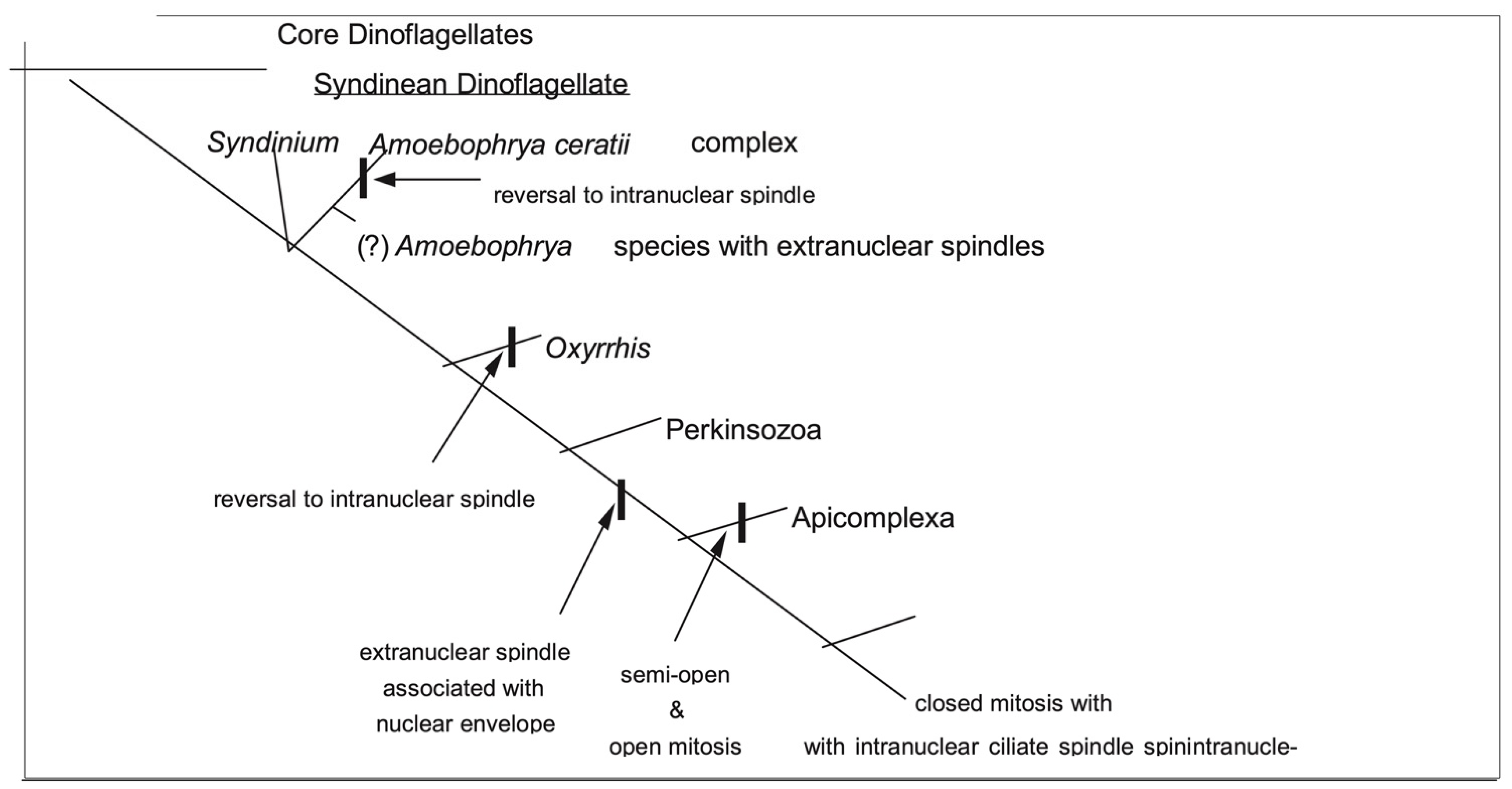



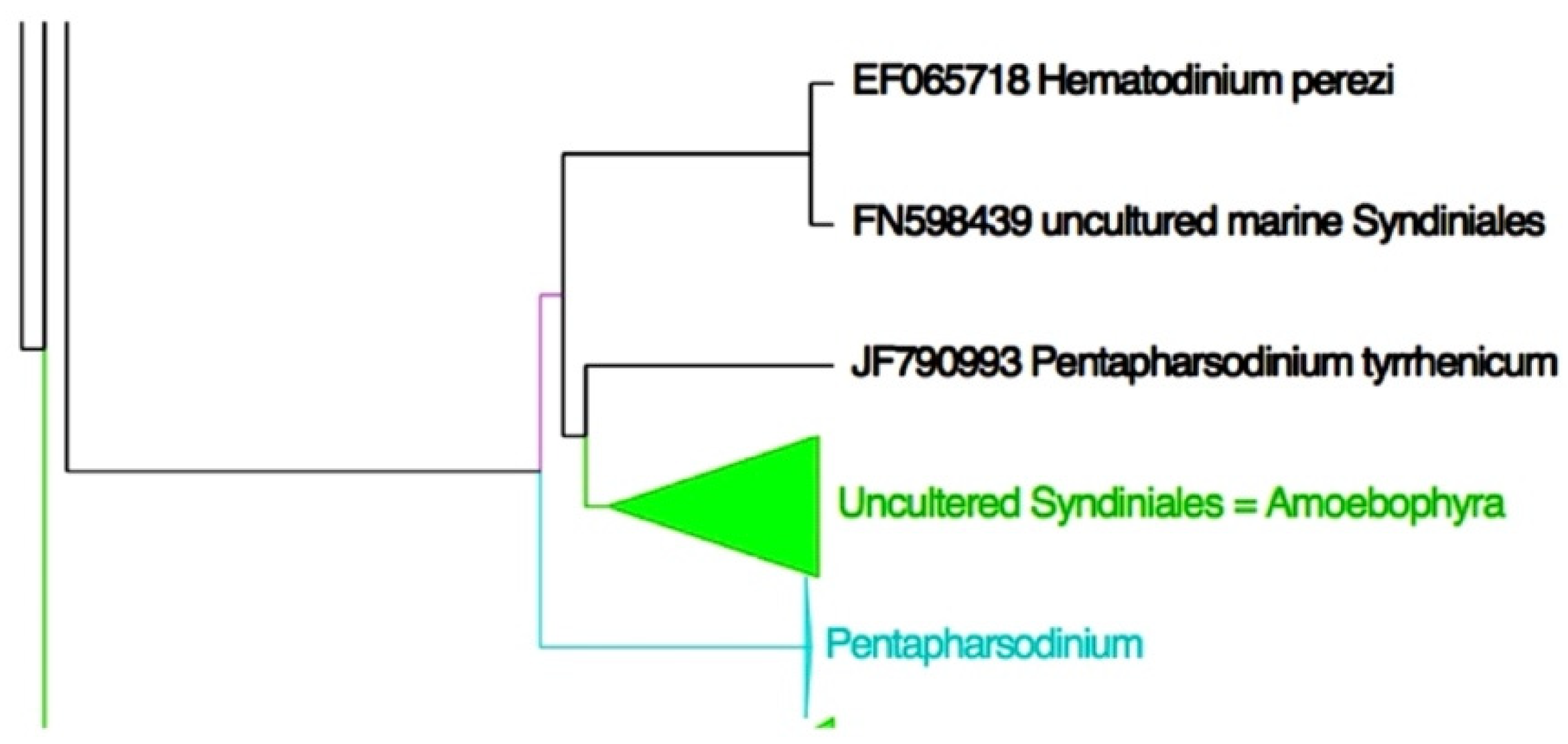
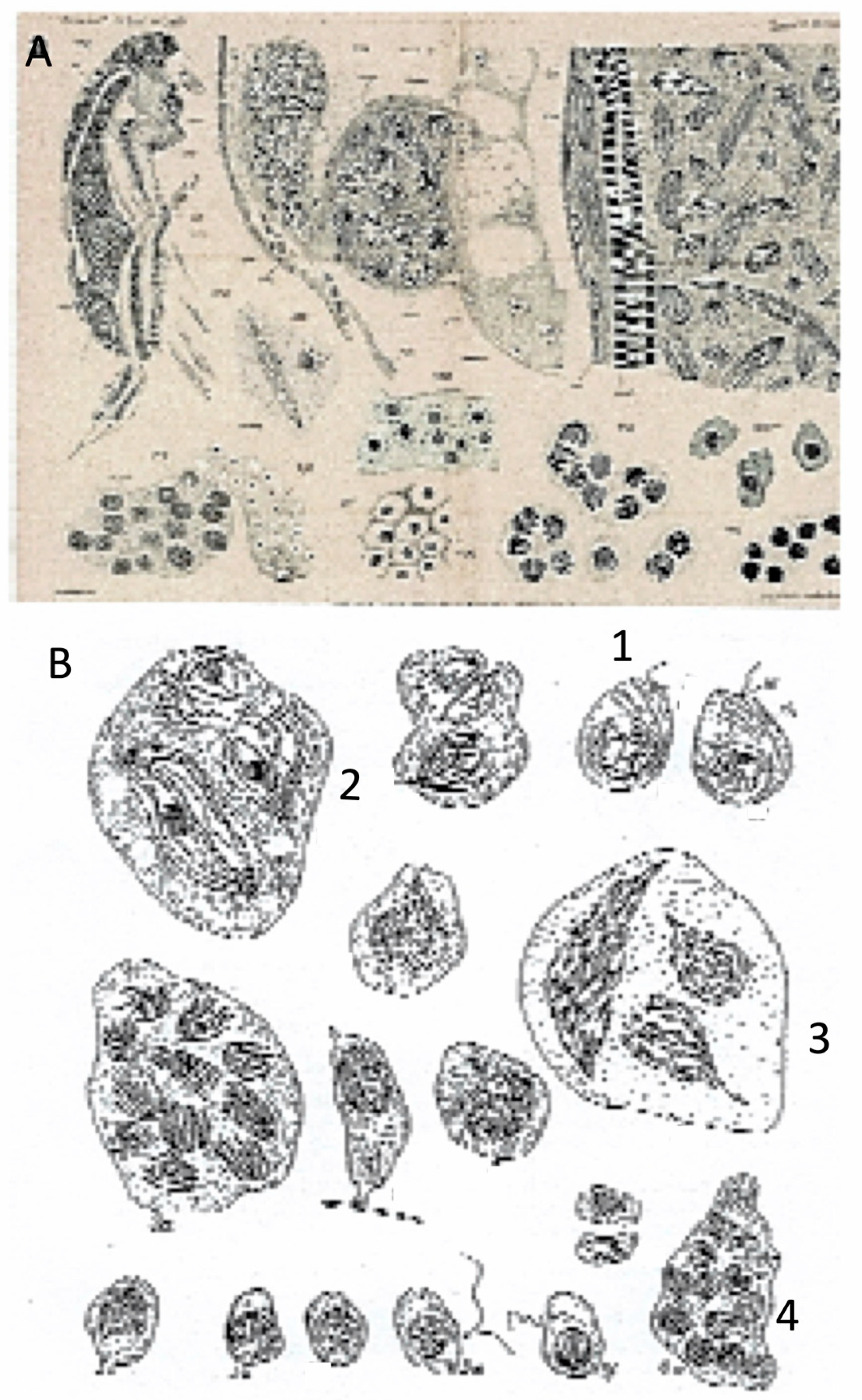


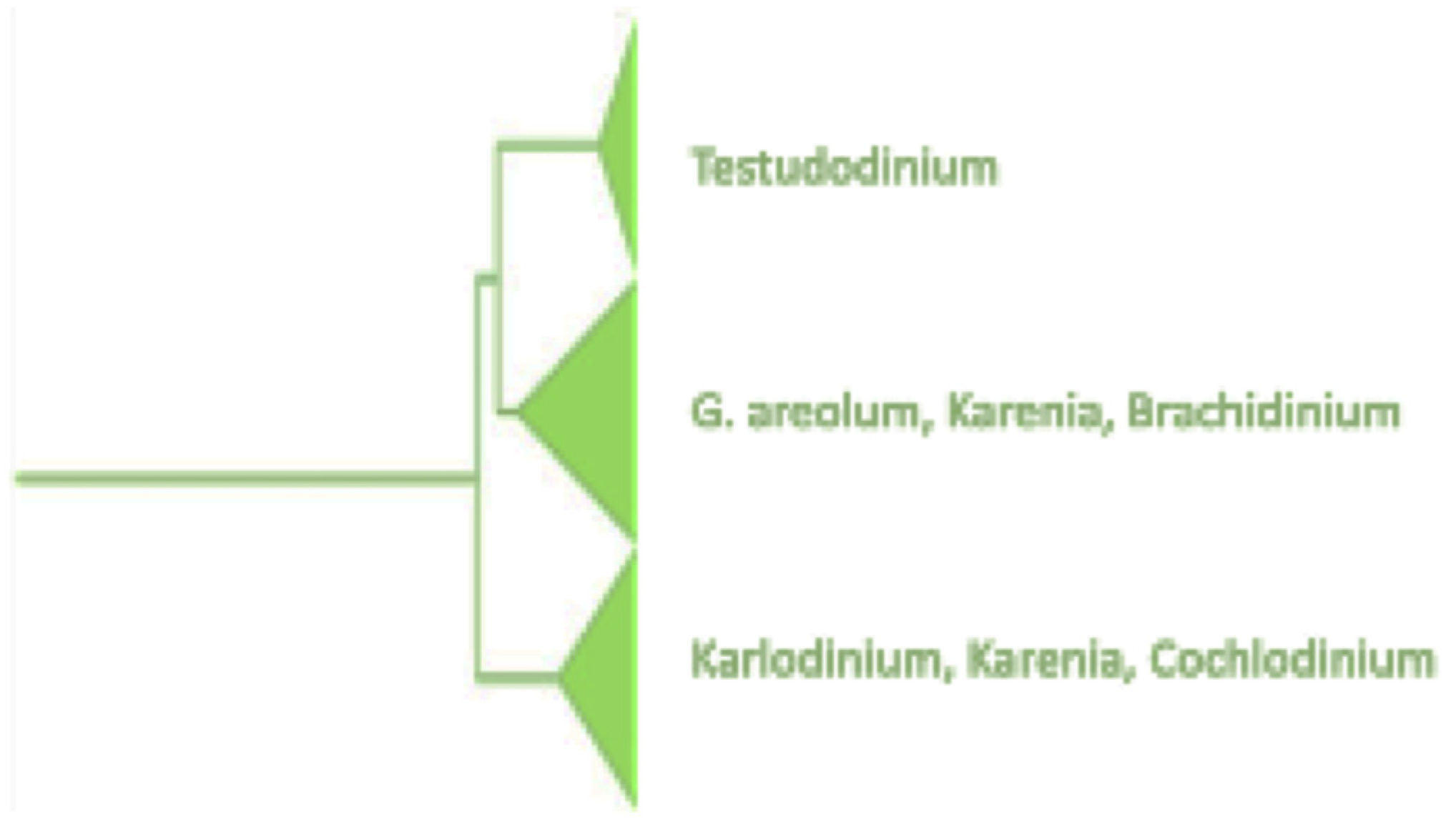


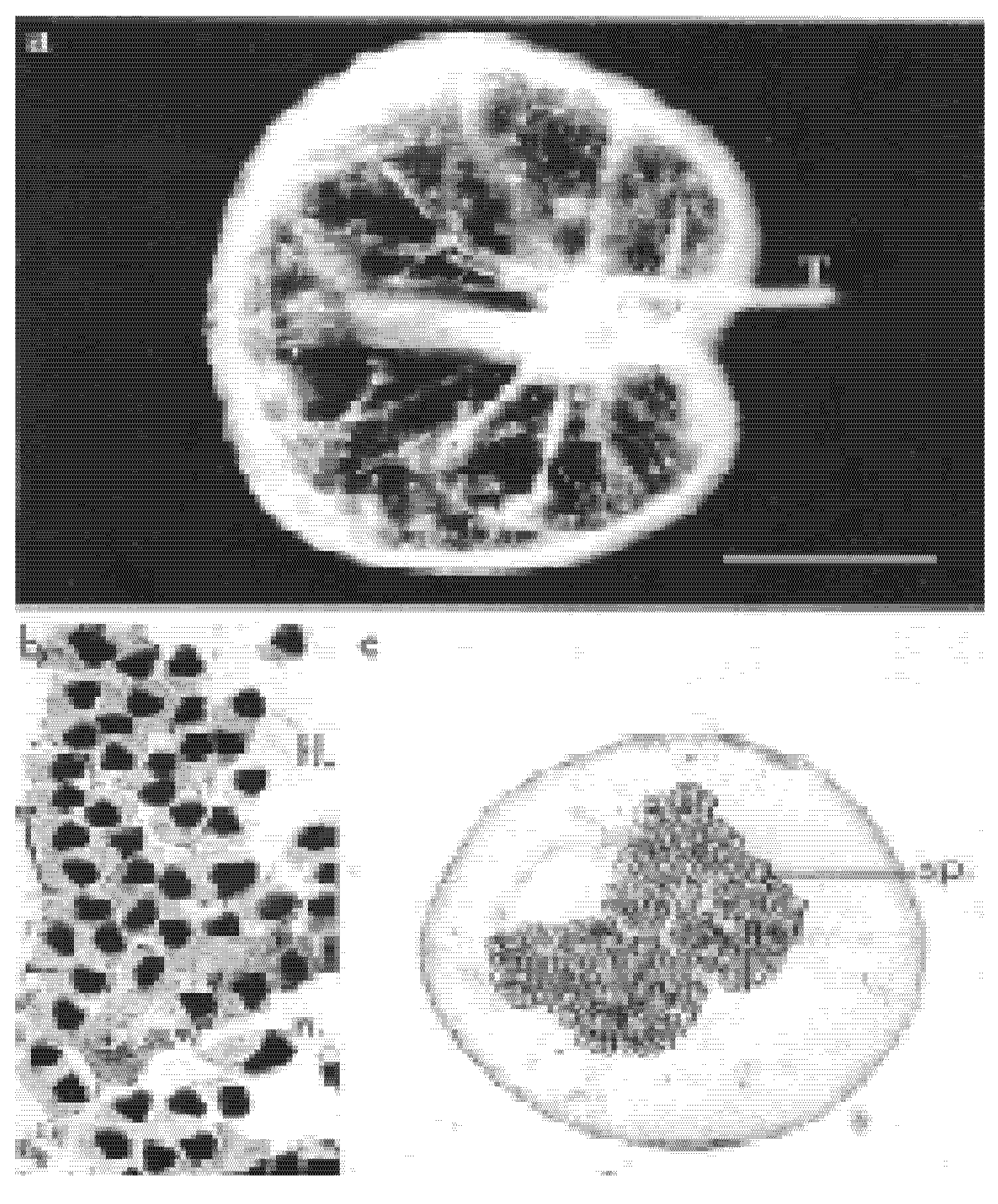
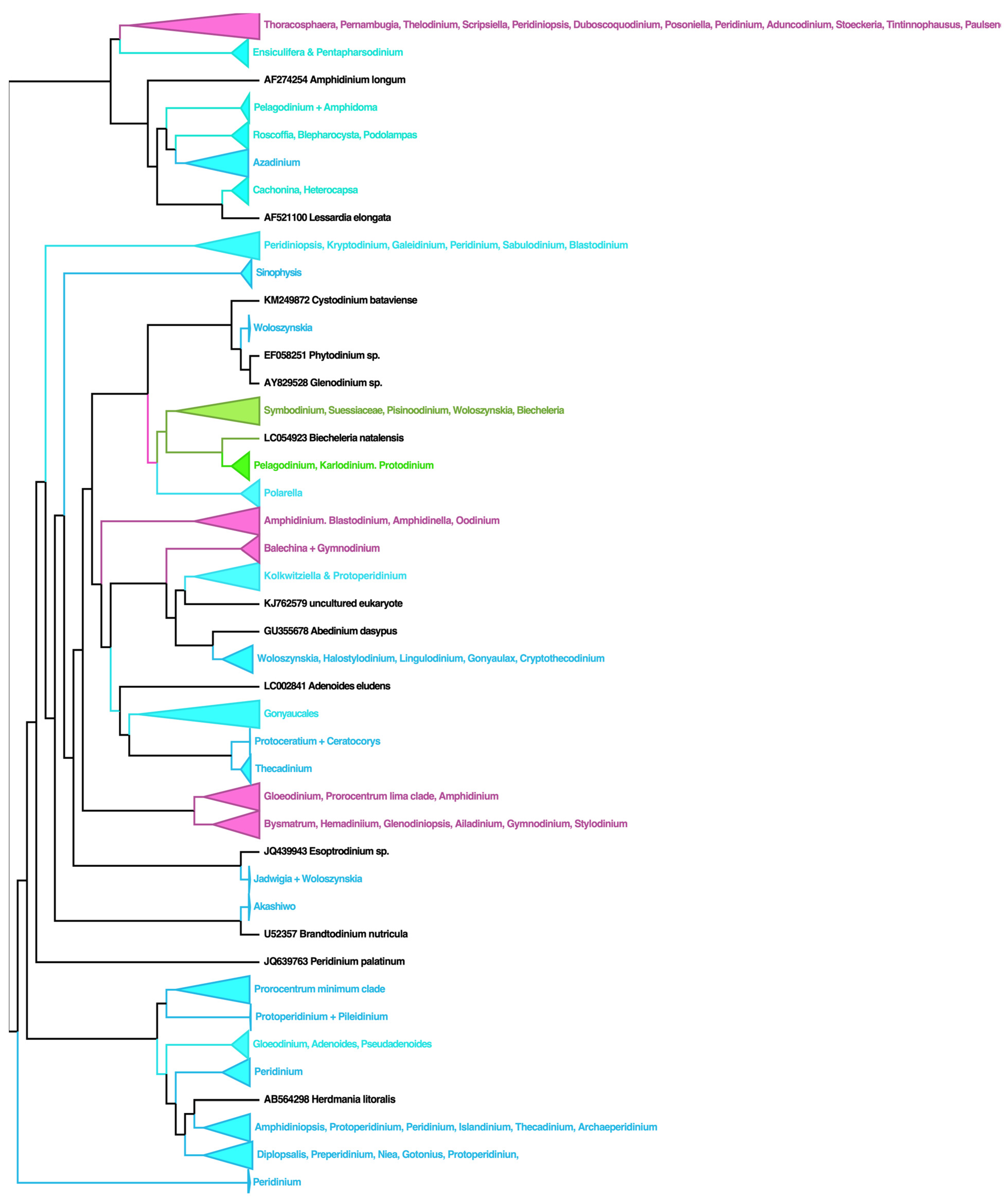

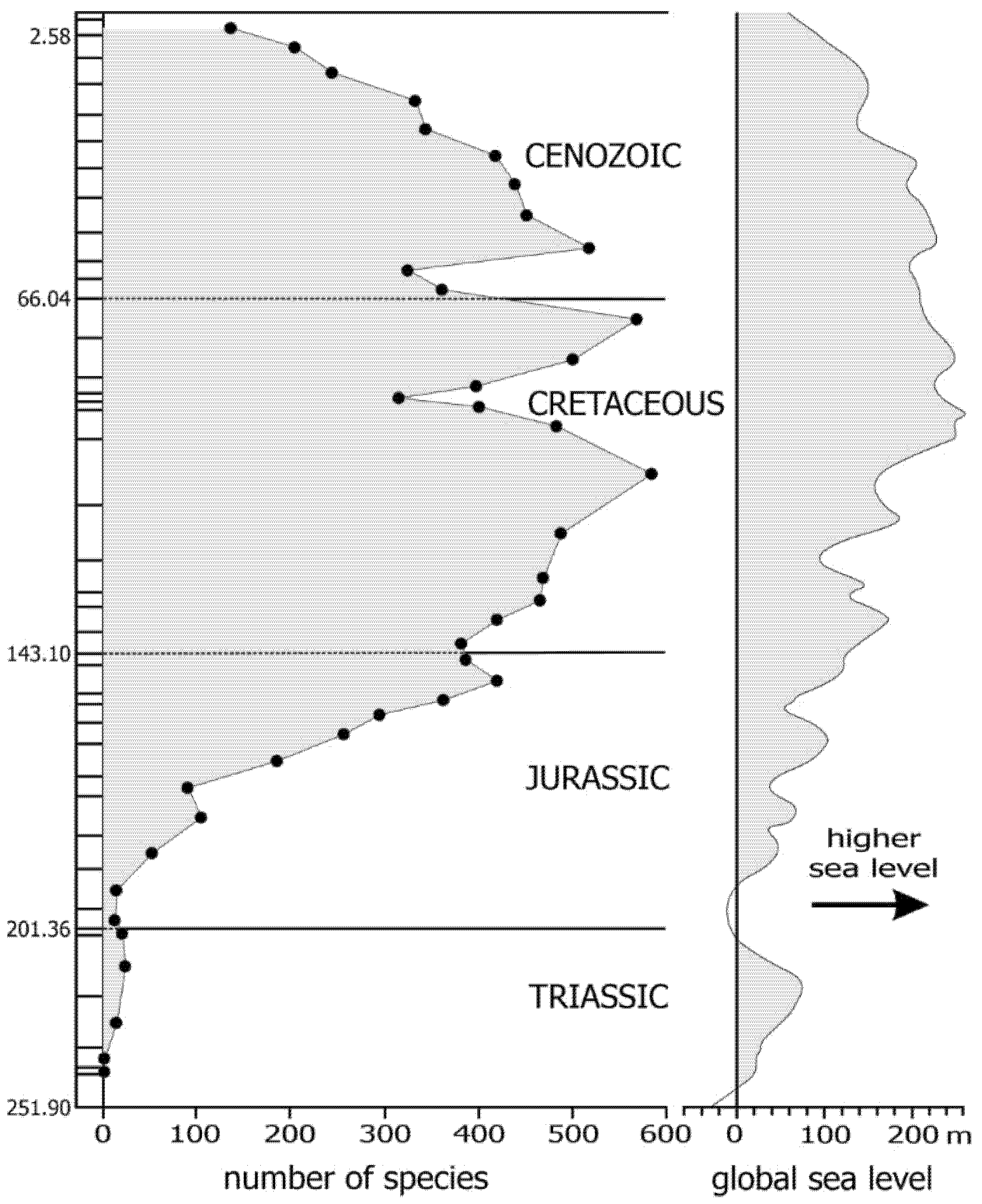
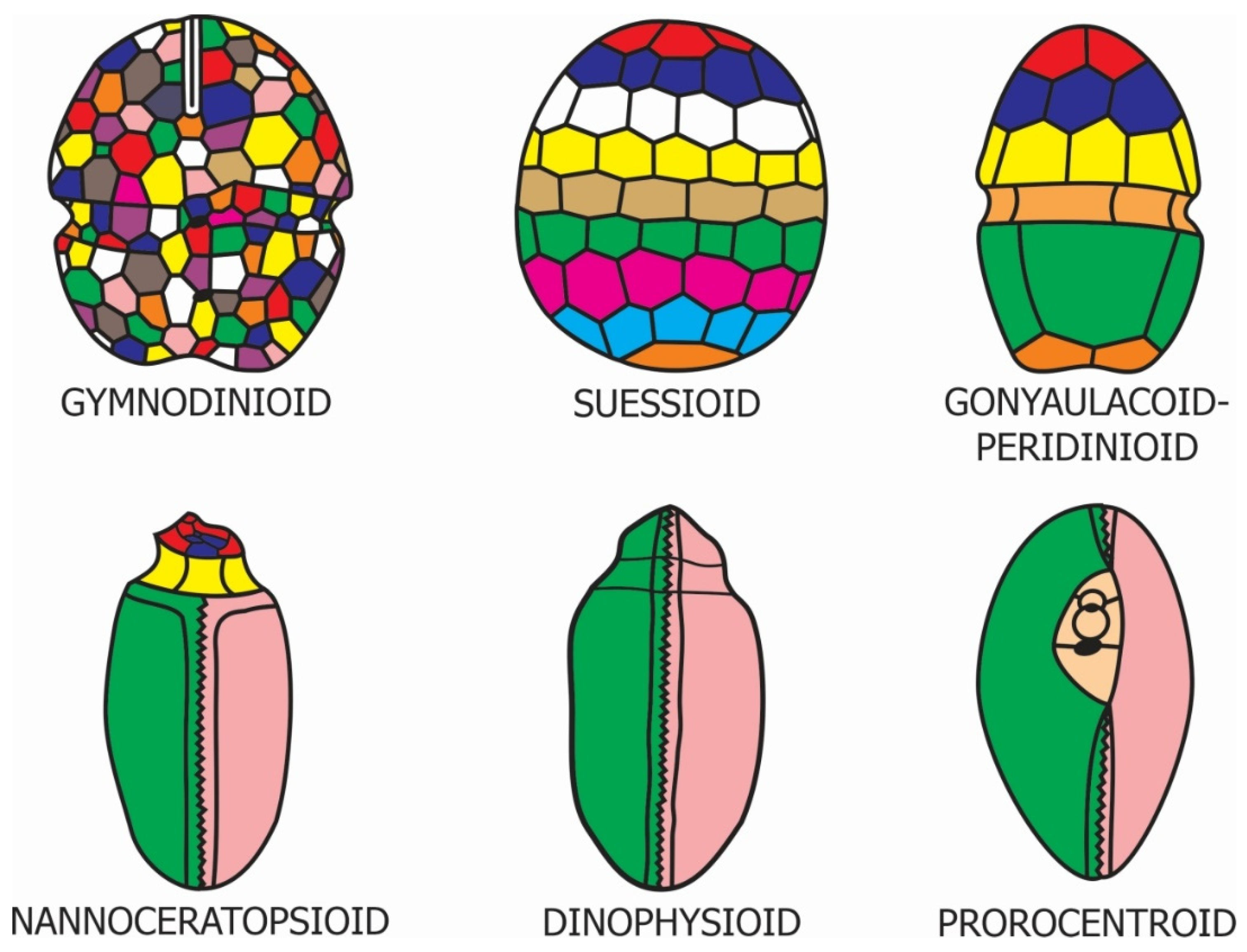
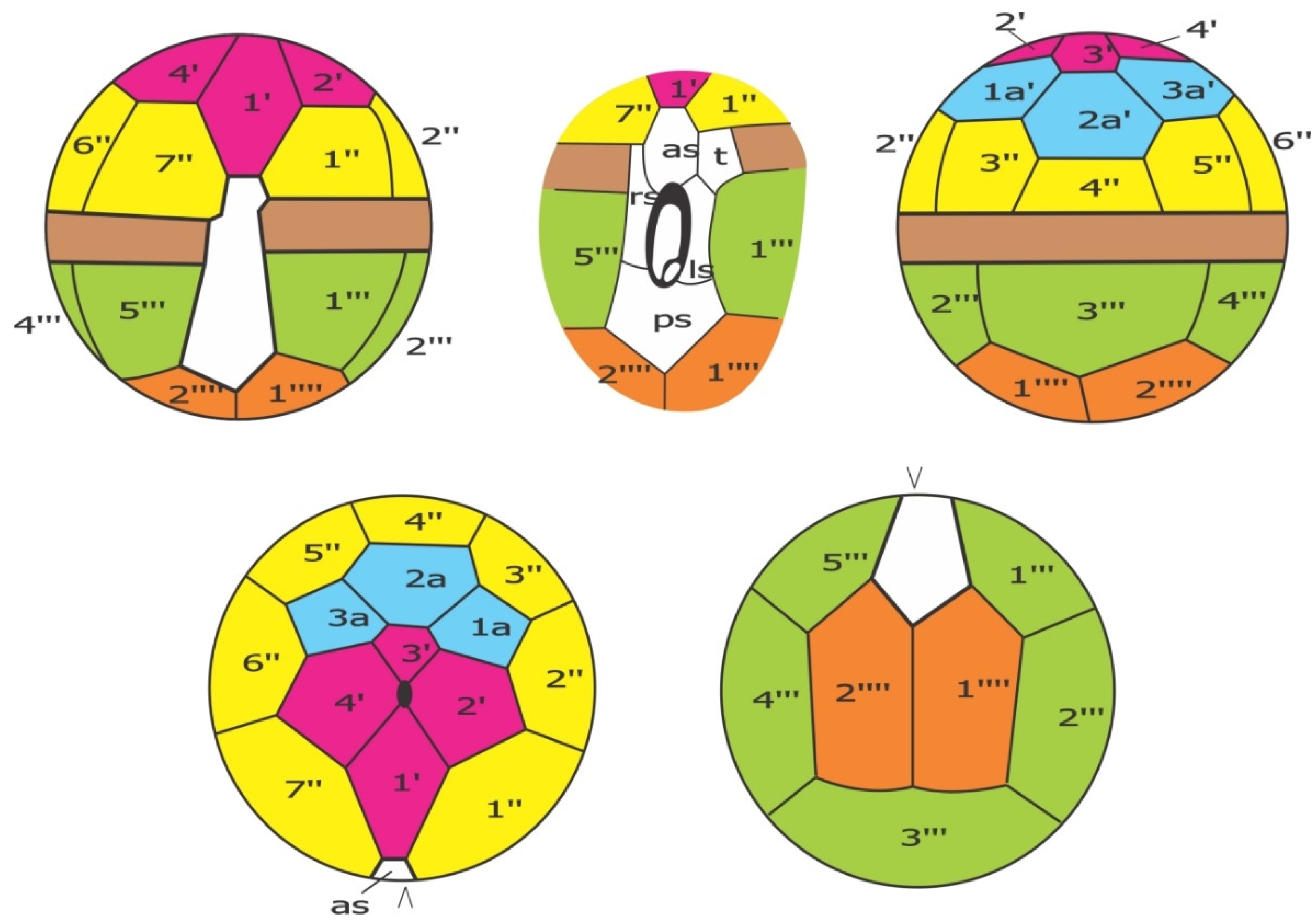
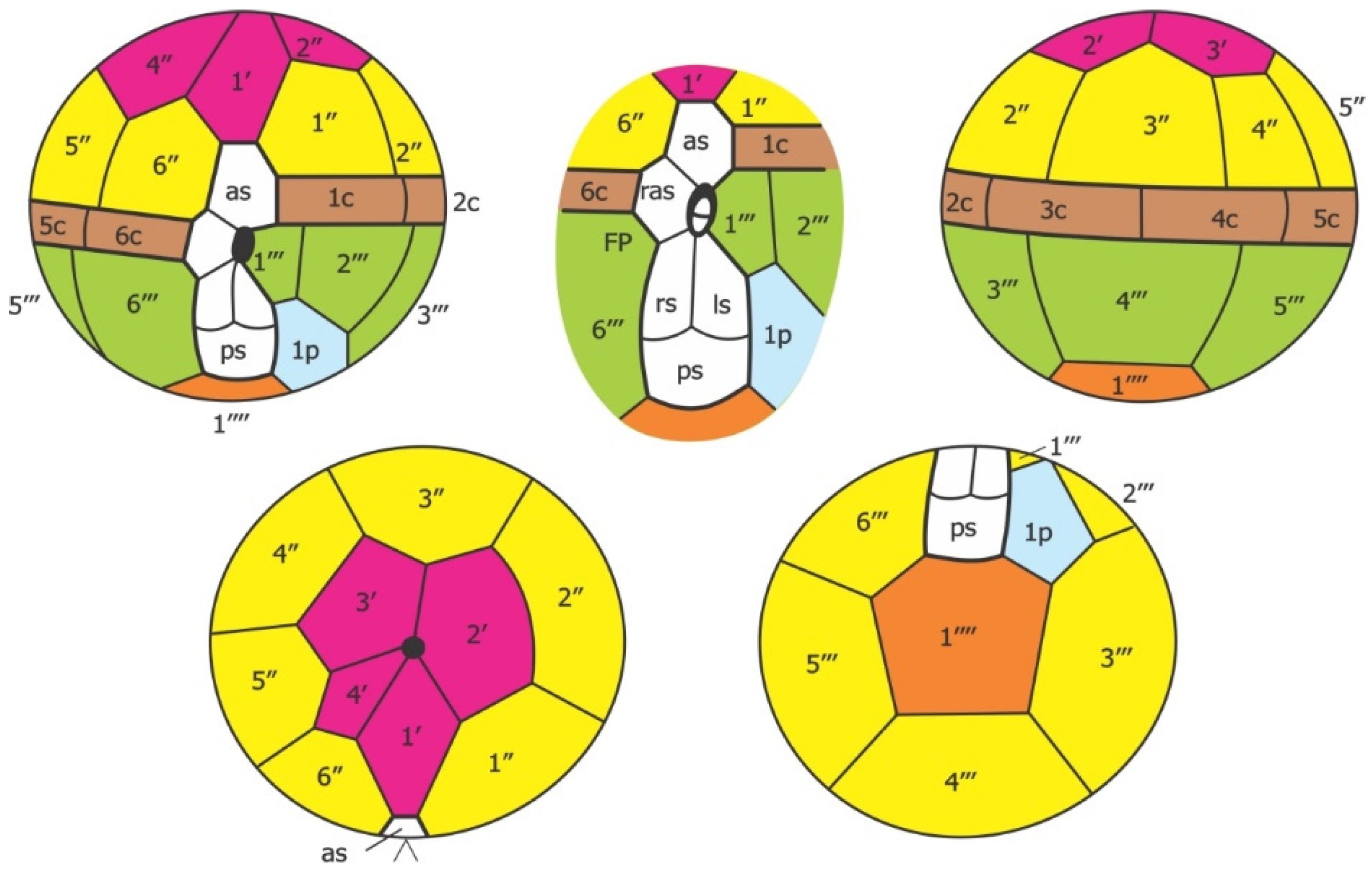
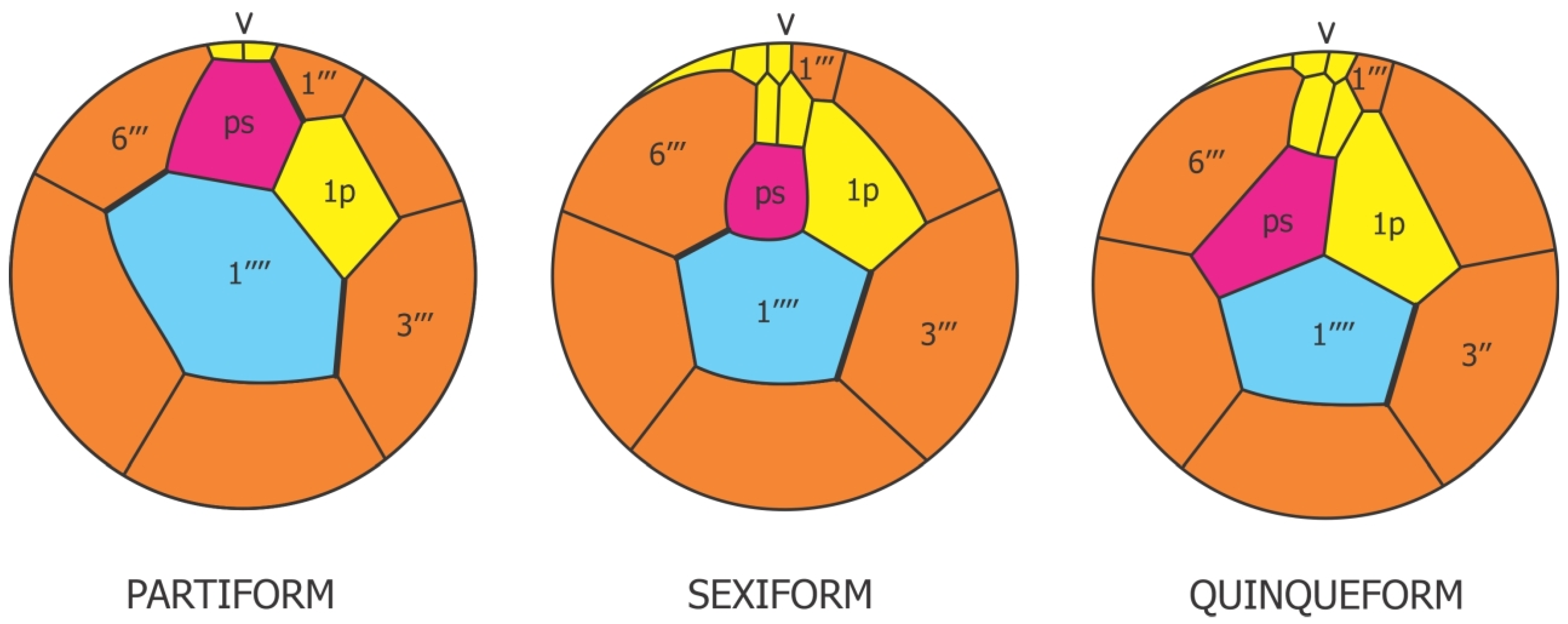

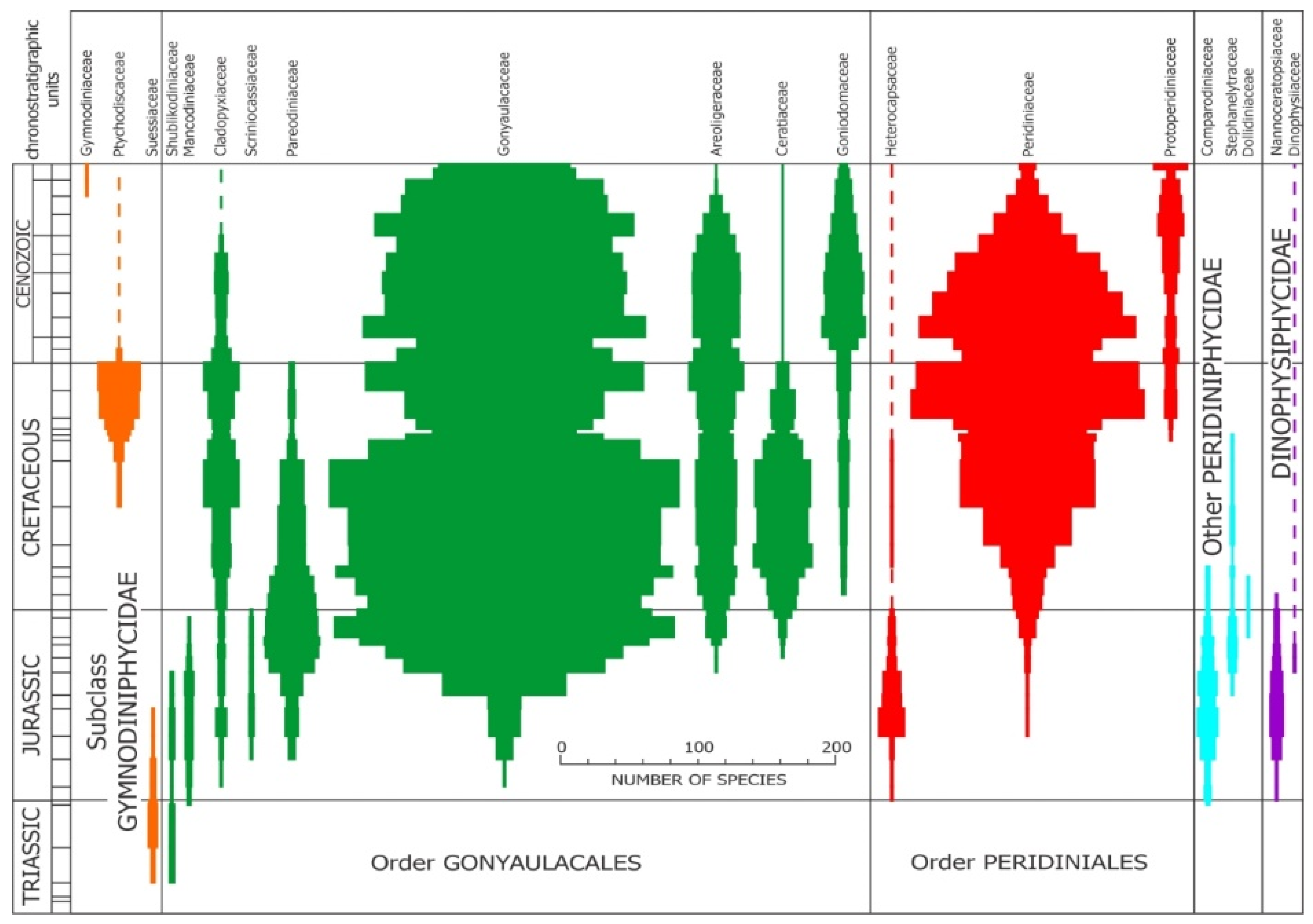
| Gametes | Zygotes | |||||||
|---|---|---|---|---|---|---|---|---|
| Species | F or M a | Different from Vegetative Cells b | Iso (+) or Aniso (-) Gamy | Naked (-) or Thecate (+) | Fertilisation Tube c | Protoplasmic Fusion d | Planozygote (Number of Flagellae) e | Hypnoyzygote f |
| Peridinium cinctum | F | + | - | - | ? | + | + 2 | + |
| F | + | - | -/+ | + | + | + 4 | + | |
| Peridinium willei | F | + | - | - | - | + | + 2 | + |
| P. gatunense | F | + | - | + | + | + | + ? | + |
| P. volzii | F | + | - | -/+ | + | + | + ? | + |
| P. limbatum | F | + | - | + | - | + | + ? | + |
| P. inconspicuum | F | + | - | + | ? | + | + ? | + - |
| P. cunningtonii | F | + | - | -/+ | - | + | + 4 | + |
| Gymnodinium excavatum | F | + | - | ? | ? | ? | + ? | + |
| G. paradoxum | F | + | - | ? | ? | ? | + ? | + |
| G.. pseudopalustre | F | + | - | ? | + | + | + 4 | + |
| Gymnodinium. breve | M | + | - | + | - | + | + 4 | - i |
| Gyrodinium uncatenatum | M | + | + | + | + | + | + 4 | + |
| Woloszynskia apiculata | F | + | - | + | + | + | + 4 | + |
| Ceratium cornutum | F | + | + | + | + g | + h | + ? | + |
| C. horridum | M | + | + | + | + g | + h | + ? | + |
| Oxyrrhis marina | M | + | - | ? | ? | ? | + ? | ? |
| Crypthecodinium cohnii | M | + | + - | ? | ? | + | + ? | + |
| M | ? | + - | + | + | + | + ? | + | |
| Gonyaulax tamarensis | M M | + + | + ? | ? ? | - ? | + ? | + 4 + ? | + + |
| G. excavata | M | ? | ? | ? | ? | ? | ? | + |
| G. monilata | M | + | - | + | - | + | + 4 | + |
| Protogonyaulax catenella | M | + | - | + | - | + | + ? | + |
| Helgolandinium subglobosum | M | + | + | ? | ? | ? | + ? | - |
| Amphidinium carteri | M | - | - | ? | + | + | + ? | + |
| Noctiluca miliaris | M | + | - | - | - | + | + 0 | ? |
| Protocentrum micans | M | - | - | + | + | - | + 2 | - |
Disclaimer/Publisher’s Note: The statements, opinions and data contained in all publications are solely those of the individual author(s) and contributor(s) and not of MDPI and/or the editor(s). MDPI and/or the editor(s) disclaim responsibility for any injury to people or property resulting from any ideas, methods, instructions or products referred to in the content. |
© 2022 by the authors. Licensee MDPI, Basel, Switzerland. This article is an open access article distributed under the terms and conditions of the Creative Commons Attribution (CC BY) license (https://creativecommons.org/licenses/by/4.0/).
Share and Cite
Riding, J.B.; Fensome, R.A.; Soyer-Gobillard, M.-O.; Medlin, L.K. A Review of the Dinoflagellates and Their Evolution from Fossils to Modern. J. Mar. Sci. Eng. 2023, 11, 1. https://doi.org/10.3390/jmse11010001
Riding JB, Fensome RA, Soyer-Gobillard M-O, Medlin LK. A Review of the Dinoflagellates and Their Evolution from Fossils to Modern. Journal of Marine Science and Engineering. 2023; 11(1):1. https://doi.org/10.3390/jmse11010001
Chicago/Turabian StyleRiding, James B., Robert A. Fensome, Marie-Odile Soyer-Gobillard, and Linda K. Medlin. 2023. "A Review of the Dinoflagellates and Their Evolution from Fossils to Modern" Journal of Marine Science and Engineering 11, no. 1: 1. https://doi.org/10.3390/jmse11010001
APA StyleRiding, J. B., Fensome, R. A., Soyer-Gobillard, M.-O., & Medlin, L. K. (2023). A Review of the Dinoflagellates and Their Evolution from Fossils to Modern. Journal of Marine Science and Engineering, 11(1), 1. https://doi.org/10.3390/jmse11010001






